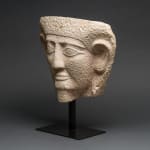Late Dynastic Period Stone Sarcophagus Fragment of a Head, 712 BCE - 332 BCE
Stone
height 35.9 cm
height 14 1/8 in
height 14 1/8 in
X.0393
The funerary rites and rituals of Egypt are among the most elaborate and celebrated burial traditions in the ancient world. The foremost concern was the preservation of the body, in...
The funerary rites and rituals of Egypt are among the most elaborate and celebrated burial traditions in the ancient world. The foremost concern was the preservation of the body, in order that it might be reborn in the afterlife. While the painstaking mummification process achieved this goal of counteracting the effects of physical decomposition, the ancient Egyptian were not satisfied with a wrapped body alone. Gorgeously decorated mummy cases and sarcophagi developed over the course of thousands of years so that the body could be properly presented to the audience of the gods awaiting the deceased’s arrival in the next world. These cases were created from a variety of materials, including stone, wood, and cartonnage, that were utilized depending upon the wealth and status of the deceased. Some of the earliest examples were relatively unadorned, featuring the general shape of the body highlighted by idealized facial details. Later, they evolved into ornate memorials that sought to recreate the specific appearance of the memorialized individual, both in terms of physical feature as well as clothing and jewelry. Polychrome paint infused the works with color and the finest examples were gilt.
This gorgeous fragment comes from the front of an anthropomorphic sarcophagus lid that would have once held the body of the deceased. Here, the artist has clearly succeeded in capturing the individualized facial feature of the deceased, infusing his natural appearance with a healthy dose of idealism. His carefully defined eyes and brow are perhaps his most prominent feature. He has large ears that have been framed by a wig that crowns his head. He smiles softly, imbuing the work with a humane warmth we can easily identify with. A false beard has been attached to his square chin, an attribute typically associated with deities that became a symbol of Pharaonic power. His eyes continue to haunt us centuries later, drawing us in with their strong lines. Created during the period of time that marked the end of the Egyptian Kingdom and the beginning of the Ptolemaic Dynasty when Greek kings ruled the land, this gorgeous mask reveals that traditional Egyptian art forms continued to thrive despite the increasing influences of Hellenistic tastes.
This gorgeous fragment comes from the front of an anthropomorphic sarcophagus lid that would have once held the body of the deceased. Here, the artist has clearly succeeded in capturing the individualized facial feature of the deceased, infusing his natural appearance with a healthy dose of idealism. His carefully defined eyes and brow are perhaps his most prominent feature. He has large ears that have been framed by a wig that crowns his head. He smiles softly, imbuing the work with a humane warmth we can easily identify with. A false beard has been attached to his square chin, an attribute typically associated with deities that became a symbol of Pharaonic power. His eyes continue to haunt us centuries later, drawing us in with their strong lines. Created during the period of time that marked the end of the Egyptian Kingdom and the beginning of the Ptolemaic Dynasty when Greek kings ruled the land, this gorgeous mask reveals that traditional Egyptian art forms continued to thrive despite the increasing influences of Hellenistic tastes.



